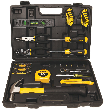Installing a shower in your bathroom is a project that most people can do, at least if they are willing to get a little dirty. It's not all that difficult, and these instructions will tell you how you can do it yourself. That being said, there have been a couple of assumptions made. For example you already have basic plumbing installed in your bathroom, and that you have already removed the walls to expose the plumbing where you want the shower. Furthermore, this project assumes that you have any necessary permits to actually do the building.
- Get measurements. In order to install a shower, you need to get measurements of the area that you will be working in. Use a tape measure, and carefully measure the height, width, and depth of the area you want to have the shower installed in. Write down the measurements, and then double check them.
- Choose your kit. Take the measurements with you to your local home improvement store, and look around for the particular model of shower kit that you want. The easiest ones to work with, and that these instructions assume you got, are the all in one kits that include the floors and walls to fit in a corner. Take the kit home.
- Read the instructions. When you get the kit home read though the instructions at least twice. This will allow you to be familiar with that process that the manufacturer suggests you use to install the shower. In addition this will allow you to get an idea of any tools or other items that you need to get.
- Set and mark the base. Set the base of the shower kit where you want it, but do not permanently install it. With it in place, go ahead and mark where the drains are going to be located. If you are using a kit where the walls and base are all part of a single unit, take the time to also mark where you will want the showerhead and faucet handles will go. Once you have finished doing that go ahead and remove the base so you can continue with the installation.
- Follow the installation instructions. For most showers this is when you will install any drain additional plumbing (such as the riser pipe, and mixing valve) among other parts. Each manufacturer has their own particular order for how this is done, so make sure that you carefully follow the instructions from the manufacturer as indicated. Take your time, since a hasty job will often look shoddy. Generally speaking you will want to install all the pipes, and then the base and walls, followed by the faucet handles and shower head. Finish up by installing drain covers.
- Caulk the seams. With all the parts in place you can then begin caulking any seams. This will help prevent any mold or mildew growth once you start using the shower. The best type of caulking that you will want to use is a silicone based one. Again, take your time as you apply the caulking, and be sure to lightly rub your finger over the bead so that it will smooth out over the seam.
- Turn the water on. Once you have finished caulking and allowed it to dry completely, you can turn the water on. Slowly start the water back up so that you don't get any air bubbles in the pipes, and so you don't overload the pipes. With the water on, you can basically begin showering any time you want.
- Clean up. After you have finished turning the water on, and even tested your work, you are pretty much done. All you have left to do is clean up the mess you made. Congratulations, you have finished installing a shower.
If at any time during this project you feel like you can't complete it at your current skill level, stop and call a professional in. This will help prevent you from making a costly mistake, and creating even more work than you originally expected. There is no shame to admit that you need help if you find yourself in over your head.
Author Bio
Lee Wyatt
Contributor of numerous Tips.Net articles, Lee Wyatt is quickly becoming a regular "Jack of all trades." He is currently an independent contractor specializing in writing and editing. Contact him today for all of your writing and editing needs! Click here to contact. Learn more about Lee...
Toxic Table Scraps
On the average, toxic table scraps can lead to more emergency visits to the pet doctor than any other reason. Avoid the ...
Discover More
Garden Flowers
A beautiful garden full of flowers is the dream of many home gardeners. After all, who wouldn't want to have a garden ...
Discover More
Removing Permanent Marker from Vinyl
Considering how common both vinyl and permanent markers are it only stands to reason that the two will come into contact ...
Discover More
More Home Improvement Tips
What are Compression Faucets?
Have you ever wondered what compression faucets are? Chances are pretty good that you have wondered that at least once, ...
Discover More
Repairing a Leaking Tank
Over time just about everything will leak, and your toilet is no different. Perhaps one of the more annoying locations ...
Discover More
What is a Pipe Diverter?
What is a pipe diverter? If you are new to plumbing, then chances are you have many questions like this. Well, if you are ...
Discover More

Comments